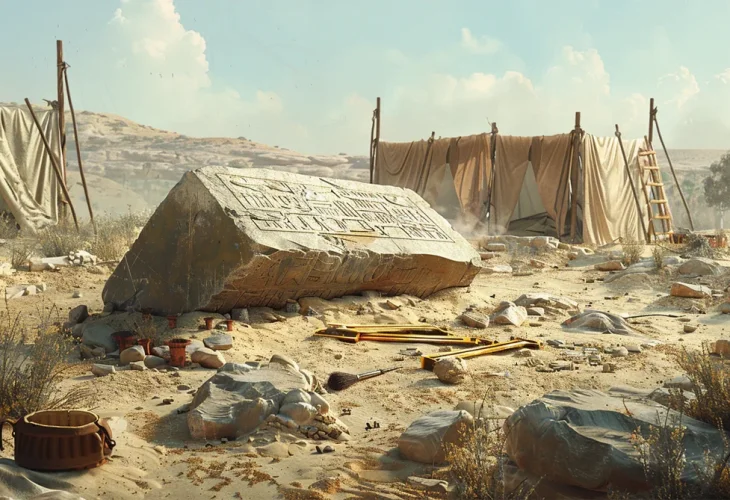History and Archaeology
An Ancient Discovery Connecting to King David’s Dynasty
A surprising find in northern Israel gave the first historical proof that King David really existed

Abraham Biran walked slowly through the dusty excavation site of Tel Dan, a place hiding thousands of years of Jewish history beneath the soil. Around him, his students were hard at work, crouched over trenches, carefully brushing away dirt from ancient fragments. Every tiny grain of earth was treated as if it could be holding a secret.
Suddenly, a shout rang out: “Professor! Come quickly!”
Biran, used to getting excited calls during digs that often led to nothing, came over quickly. But this time, something felt different. One of his students, Gila Kuk, pointed to a large piece of black basalt stone sticking out of the ground. On its surface were engraved lines of ancient Aramaic, written in Phoenician-style letters.
The dust hadn’t even settled yet, but the excitement was real. Biran could feel it in his bones: this was no ordinary find.
A few days later, after the piece was cleaned and examined, its significance became clear. It was a victory inscription written by an Aramean king, most likely King Hazael of Aram bragging about his defeat of the kings of Israel and Judah. But what left the scholars stunned were two small words carved into the middle of the stone: “House of David.”
This was the first time in history that someone found a reference to King David outside the Bible. Until then, some people had claimed that David was just a legend or a character in a parable. But this quiet piece of stone was shouting the truth: King David had really lived. He was known even to Judah’s enemies, who recognized his family as a royal dynasty.
And the story didn’t end there. In 1994, a year later, during more digging, two more fragments of the same stone were discovered. One was found underneath the floor near the city gate, beside five standing stones used for idol worship. The other was found again by Gila Kuk. It turns out that in ancient times, the broken pieces of this victory stone had been intentionally buried under the gate plaza, so that people walking into the city would step on the words of the king who had conquered them. It was a quiet act of resistance and pride.
The Davidic dynasty is at the heart of Jewish belief. It was through this dynasty that Hashem chose to establish the Beit HaMikdash (Holy Temple). David’s son, Shlomo HaMelech (King Solomon), built the Temple in Jerusalem. But the dynasty is more than just about kings and power, it represents the future of the Jewish people. It holds the promise of the Geulah (redemption), because the Mashiach, who we pray will come soon, must be a direct descendant of King David.
Hashem promised David in the Tanach: “There shall never fail a man from your seed on the throne of Israel” (Jeremiah 33:17). We repeat this promise often in our prayers, especially in the weekday Amidah, when we ask: “May You speedily cause the offspring of Your servant David to flourish.” It’s a prayer of deep hope and faith that Hashem’s word will be fulfilled.
Because of this, the idea of a real King David has become a target for some modern-day skeptics especially those with anti-religious views. For them, it’s not just about archaeology. If King David existed, then the Tanach is not just a storybook, it’s history. It means the Jewish people have deep roots in the land of Israel, and that the connection between the land, the people, and Hashem is real.
So they claimed: “There never was a King David. There was no united kingdom of Israel and Judah. It’s all a myth created later to invent a national identity and justify power.”
You might think that the discovery of the Tel Dan inscription would change their minds. But instead, many doubled down. Their objections weren’t serious academic arguments. They began to suggest far-fetched ideas like maybe “House of David” referred to some random person named David, whose name just happened to become famous enough that a foreign king would carve it into stone. The logic didn’t matter, as long as they didn’t have to admit that the Bible might be telling the truth.
This isn’t how real science works. Real research follows the evidence, even when it challenges your assumptions. But in this case, the assumption is that the Bible can’t be true. And so any proof that supports it must be explained away, no matter how far-fetched the explanation is.
At the end of the day, a quiet piece of stone, hidden in the dirt for thousands of years, speaks louder than pages of doubt. It tells us that David lived, that his name mattered, and that the story of Am Yisrael is not just faith, it’s history.

